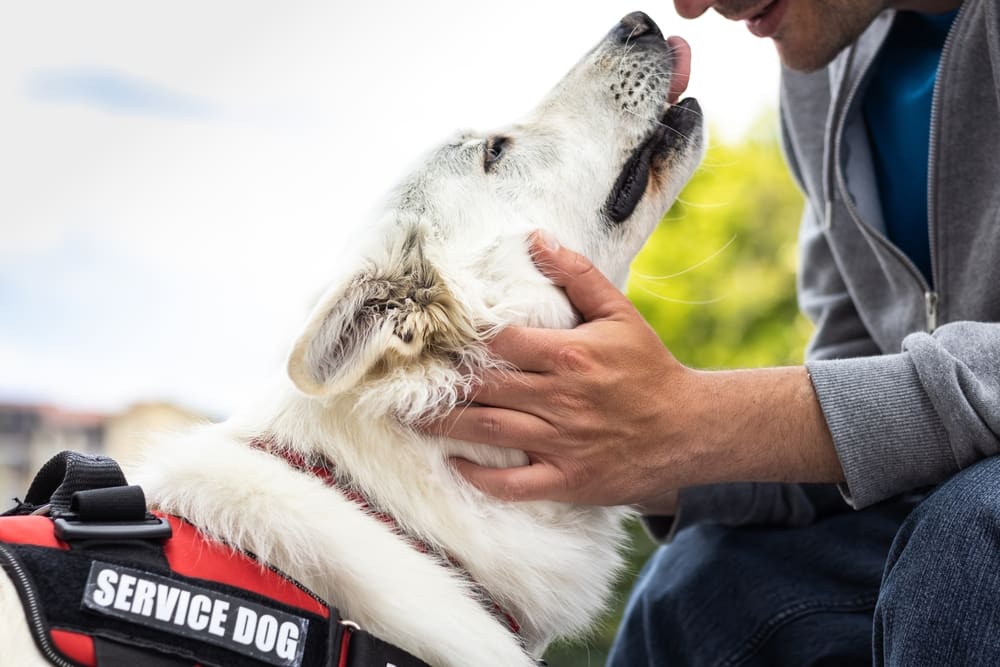Autism spectrum disorder (ASD), a neurodevelopmental disorder that manifests differently in every individual, can be extremely debilitating and overwhelming.
A service dog can help provide an individual with autism both physical and emotional support in their everyday life. This allows them to live more independently, build meaningful connections, and navigate environments they would usually find overwhelming.
What’s more, a service dog’s unconditional love and companionship can ease feelings of loneliness (which many people with autism sadly experience).
Today, we’ll discuss what an autism service dog is, what tasks they typically perform, and what legal protections they receive. We’ll also cover the various ways to obtain an autism service dog and how to decide whether this intervention option is suitable for your needs.
What Is a Service Dog?


Under the Americans with Disabilities Act (ADA), a service dog is a working dog that has been “individually trained to do work or perform tasks for people with disabilities.” This includes physical disabilities such as hearing difficulties and impaired vision, and both emotional and mental disorders (like PTSD, anxiety, and bipolar disorder).
The tasks performed must also be specifically related to the person’s disability and help ease symptoms. Some common tasks include crowd control, retrieving medication, tactile stimulation, and deep pressure therapy. The exact tasks a service dog provides will ultimately depend on their handler’s individual needs.
Dogs of any size, breed, or age can become recognized as service dogs as long as they perform disability-related tasks. However, some breeds tend to excel at service work more than others due to their high trainability and ability to stay alert without being reactive. These breeds include Labrador retrievers, cavalier King Charles spaniels, border collies, and poodles.
Service dogs are also often categorized based on the type of support they offer. Some of the most common types are:
- Guide dogs
- Hearing dogs
- Psychiatric service dogs (PSD)
- Sensory signal dogs
- Diabetic alert dogs
- Mobility assistance dogs
Service Dogs vs Emotional Support Animals (ESAs) vs Therapy Dogs
Service animals and emotional support animals both assist individuals with disabilities — but that’s the only similarity they share.
Unlike service animals, emotional support animals are not specially trained to perform disability-related tasks and instead relieve symptoms through their physical presence and companionship. Any species can also become recognized as an ESA, including rabbits, cats, hamsters, spiders, and reptiles.
Due to this distinction, emotional support animals and service dogs are entitled to different legal protections under both federal and state laws. For example, the ADA does not recognize emotional support animals and does not grant them public access rights.
To add to the confusion, therapy dogs are another type of working animal. However, unlike service dogs and ESAs, they don’t assist a specific individual. They “volunteer” at public settings like hospices, schools, and nursing homes and provide comfort and reassurance to those living or working in such environments.
Therapy dogs don’t undergo any training, but must be well-behaved, be comfortable in new environments, and have a gentle, calm temperament.
How Can a Service Dog Help With Autism?


Autism spectrum disorder can impact several aspects of an individual’s life, including learning, building relationships, and communicating with others. Autism affects every person differently, though some common signs of this condition include:
- Difficulties adapting to changes in routine
- Finding it hard to understand other people’s speech, tone of voice, and facial expressions
- Heightened sensitivity to lights, noises, and smells
- Avoiding eye contact
- Anxious about social situations
- Difficulties in maintaining relationships or making new friends
- Difficulties in regulating and managing emotions
- Performing repetitive behaviors (including self-stimulatory behavior or “stimming”)
- Delayed language development
- Strong interest in particular activities or subjects
- Delayed movement skills
A service dog can be specially trained to perform tasks that help those with autism manage their disability and navigate day-to-day life. We’ll take a close look at some of the most common tasks below.
Manage Sensory Overload
Sensory overload occurs when the senses receive more sensory information than the brain can process. Many individuals with ASD experience sensory overload, especially in busy, public areas where there’s often plenty of noise and light.
A service dog can be specially trained to identify early signs of sensory distress and perform tasks that help ease, regulate, or even prevent sensory overload.
For example, a service dog can lead their handler to a quieter environment or perform deep pressure therapy (more on this shortly). They can also be taught to switch off lights or enter rooms first and close any doors.
Deep Pressure Therapy (DPT)
A service dog can be trained to perform deep pressure therapy, where they place their body weight onto their handler. The warmth and pressure this provides can help ground individuals when they’re feeling overwhelmed by sensory information. The sensation also has a soothing effect that can ease anxiety or stress.
A service dog can perform DPT on command or in response to certain behaviors that occur when their handler is overwhelmed, like rapid breathing, stimming, or fidgeting.
Any dog can provide DPT, though medium-to-large breeds are the best at performing this task. This is because small dogs usually don’t weigh enough to apply enough pressure to make a noticeable difference. Dogs can also provide DPT by resting their heads on their handler’s chest instead of applying their whole body weight.
Interrupt Self-Harming Behaviors
Some people with autism engage in self-harming behaviors like head banging when they’re in distress. A service dog can be trained to recognize and interrupt self-harm by nudging their handler, pushing their hands out of the way, or gently tugging on their sleeves.
Exit From Social Situations
Social interactions can be extremely anxiety-inducing and exhausting for people with autism.
A service dog can be specially trained to perform a particular command, like pawing at their handler’s hand or bumping their nose into their leg, to make it look like they need to be taken out to use the bathroom. This allows their handler to easily excuse themselves from uncomfortable social situations without drawing attention.
Service dogs can also be trained to read body language during social interactions. Then, the dog can lead their handler to the nearest exit if they detect that they’re becoming overwhelmed or finding it challenging to regulate their emotions.
Get Help
If their handler is in significant distress and requires medical aid, a service dog can be taught to alert a person nearby and make them aware of the situation.
They can also be taught to open the house front door to let in emergency responders or family members when their handler is unable to open the door themselves.
Crowd Control
A service dog can be trained to circle around their handler’s body in public areas to stop people from getting too close. This space can help prevent sensory overload, give the handler confidence to enter busy areas, and provide a sense of security.
Alert to Sounds
It can be difficult for individuals with autism to pick out and respond to vital sounds when they’re feeling overwhelmed or experiencing sensory overload. A service dog can be specially trained to detect critical sounds and alert their handler to them, helping them more easily (and quickly) process the urgent noises.
Additional Benefits of Autism Service Dogs
The tasks above are just a few of the ways trained service dogs can help individuals with autism. Here are a few more additional, life-changing benefits:
- Provide their handler with a consistent routine (i.e. exercising them and feeding them at certain times) which can help the handler feel more at ease, safe, and secure in their day-to-day life
- Grooming, petting, and holding a dog can be incredibly grounding for an individual with autism
- Can provide mobility assistance; if their handler is feeling unsteady on their feet, a service dog can position their body to offer counter resistance
- Provide unconditional love and affection (can help soothe feelings of loneliness and anxiety)
- A service dog offers a sense of familiarity, no matter where their handler is
- Can be trained to fetch certain items for their handler, including medical items, water, and food items
- Can lead their handler to a safe space if they’re disoriented
A service dog also reliably understands and responds to the commands they’re given. This can help boost their handler’s confidence in their social skills and motivate them to communicate more with others.
What Legal Protections Do Autism Service Dogs Have


Service dogs are classified as working dogs and are therefore protected under several federal laws, including the ADA, the Fair Housing Act (FHA), and the Air Carriers Access Act (ACAA). These laws provide legal rights such as:
- Employers must provide reasonable accommodations for employees with diagnosed disabilities, and that includes permitting service dogs in the workplace and making adjustments to the environment for the animal (as long as this doesn’t cause the employer undue hardship)
- Service dogs are also granted public access rights and can enter spaces like restaurants, libraries, cafes, restaurants, and shops, even if these buildings have a “no-pet” stance
- Service dogs are able to fly with their handlers on planes without being subjected to pet fees or typical restrictions
- Landlords must reasonably accommodate service dogs and can not charge pet fees or impose breed, size, or weight restrictions
The ADA also protects the privacy of those with service dogs. Employers, landlords, or other individuals can only legally ask two questions about the person’s animal. These questions are: “Is the dog a service animal required because of a disability?” and “What work or task has the dog been trained to perform?”
Autism service dogs may also receive additional legal protections, depending on the state or city you reside in. For example, some states have laws in place that grant legal protections to service dogs in training.
Do note that service dogs who are poorly trained, cause property damage, or endanger others can be denied these rights. Under the FHA, certain property types are also exempt from accommodating service animals.
Who Qualifies for Autism Service Dogs
Anyone who has been clinically diagnosed as being on the autism spectrum — and is limited in at least one or more major life activities — can qualify for an autism service dog. This includes both children and adults. However, you will need to obtain documentation from a medical professional that states you require a service dog to help manage your disability.
How to Find Autism Service Dogs
Once you’ve received the necessary documentation, you can reach out to a service dog training program in your area.
Non-profit organizations can provide a service dog for free or at very low cost. However, expect there to be strict eligibility criteria and long waiting lists. You can opt to pay a private training organization instead, though this will typically cost between $15,000 and $30,000 on average.
Another alternative is to train a service dog yourself, usually under the guidance of an experienced trainer or with assistance from an online training program. However, this requires a lot of time, dedication, and commitment on your part.
We recommend trying not-for-profit training programs first as they’re usually the most affordable (and easiest) way to obtain an autism service dog. Use the Assistance Dogs International’s search page to find non-profit service dog organizations in your area. Ask each organization directly about their eligibility criteria, process, and waiting list time.
How Do I Register an Autism Service Dog?
Despite common misconception, there is no official registry or certification process for service dogs. They also don’t need to wear identification tags, vests, or harnesses. The only requirement is that they be kept under control and tethered (unless being tethered interferes with their trained tasks).
Is an Autism Service Dog Right for Me?


Service dogs can offer immeasurable support for those struggling to manage the challenges that come with autism spectrum disorder. They can also make wonderful companions who will fill their handlers’ homes with plenty of love, affection, and comfort.
However, service dogs aren’t a suitable option for every individual — you must have the means to look after them properly and fulfill all their care needs.
With a service dog, you’re also likely to encounter many misinformed people who constantly engage with you in public and try to ask you questions about your dog or disability. This can be overwhelming and difficult to manage, especially for those with autism. You will need the confidence to advocate for yourself and defend your rights.
That’s why it’s so important to discuss whether an autism service dog is right for you with a licensed healthcare professional. They can help you determine if the benefits a service dog brings outweigh the potential cons (and what other kinds of therapies and interventions are available).




